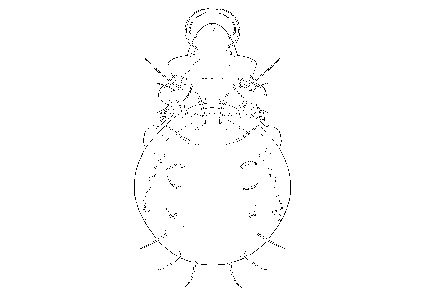Abstract
A new species of the genus Spatiodamaeus (Oribatida, Damaeidae) is described from Russia, based on adult and juvenile instars collected from bark of Acer platanoides and soil-litter of mixed and broadleaf forests in European part of Russia and Western Siberia. The adult of Spatiodamaeus kalugaensis sp. nov. is similar to S. nortoni (Bayartogtokh, 2004) comb. nov. in having epimeral neotrichy but differs from the latter by the presence of the parastigmatic tubercle Sa, the form of the parastigmatic tubercle Sp and the notogastral setae c1, c2, and the barbulation of the rostral, epimeral, anogenital, and notogastral setae of p-series. Comparisons between juvenile instars of the new species and the known juveniles of Spatiodamaeus and Epidamaeus are presented.
References
- Banks, N. (1906) New Oribatidae from the United States. Proceedings of the Academy of Natural Sciences of Philadelphia, 58, 490–500.
- Bayartogtokh, B. (2004) New Damaeid mites (Acari: Oribatida: Damaeidae) from eastern Mongolia. Acarina, 12 (1), 29–36.
- Bayartogtokh, B. (2010) Oribatid mites of Mongolia (Acari: Oribatida). KMK, Moscow, 372 pp.
- Bayartogtokh, B., Burkitbaeva, U.D. & Enkhbayar, T. (2016) Lichenophilous species of Epidamaeus and Spatiodamaeus from high mountains of Mongolia, with remarks on their ontogeny (Acari: Oribatida). Zootaxa, 4097 (3), 451–474. http://doi.org/10.11646/zootaxa.4097.4.1
- Bulanova-Zachvatkina, E.M. (1957) Bulb-legged armored mites of the family Damaeidae Berl. Communication I. Zoologichesky Zhurnal, 36 (8), 1167–1186. [in Russian]
- Bulanova-Zachvatkina, E.M. (1975) Superfamily Belboidea Dubinin, 1954 (=Damaeoidea Balogh, 1961). In: Gilyarov, M.S. & Krivolutsky, D.A. (Eds.), A Key to the Soil-Inhabiting Mites. Sarcoptifomes. Nauka, Moscow, pp. 120–143. [in Russian]
- Enami, Y. & Fujikawa, T. (1989) Two new species of the genus Epidamaeus (Acari: Damaeidae) from Japan. Edaphologia, 40, 13–20.
- Enami, Y. (1992) Life history of Epidamaeus verrucatus Enami et Fujikawa (Acari: Damaeidae), with morphological description of its immature stages. Edaphologia, 48, 21–29.
- Ermilov, S.G. (2012) Morphology of cornicles of oribatid mites of the family Damaeidae (Acari, Oribatida). Zoologichesky Zhurnal, 91 (5), 529–536. https://doi.org/10.1134/S0013873812050107
- Ermilov, S.G. & Ryabinin, N.A. (2020) Kunstidamaeus ladislavmikoi sp. nov. (Acari: Oribatida: Damaeidae) from Russia, with supplementary description of Kunstidamaeus bacillum (Kulczynski, 1926) comb. nov. International Journal of Acarology, 46 (5), 287–297. https://doi.org/10.1080/01647954.2020.1773923
- Ewing, H.E. (1909) New American Oribatoidea. Journal of the New York Entomological Society, 17, 116–136.
- Ewing, H.E. (1913) New Acarina. Part I. Bulletin of the American Museum of Natural History, 32, 93–121.
- Hammer, M. (1952) Investigations on the microfauna of Northern Canada, Part I. Oribatidae. Acta Arctica, 4, 1–108.
- Iglesias, R., Vazquez, R. & Palacios-Vargas, J.G. (2012) Desarrollo ontogenético y redescripción del adulto de Epidamaeus mitlsensillus (Acari: Oribatida: Damaeidae). Revista Mexicana de Biodiversidad, 83, 958–965. https://doi.org/10.22201/ib.20078706e.2012.4.1015
- Jacot, A.P. (1939) New mites from the White Mountains. Occasional Papers of the Boston Society of Natutal History, 8, 321–332.
- Koch, C.L. (1835) Deutschlands Crustaceen, Myriapoden und Arachniden. Heft 3. F. Pustet, Regensburg, 1 pp.
- Kulczynski, V. (1902) Species Oribatinarum (Oudms.) (Damaeinarum Michael) in Galicia collectae. Dissertationum Mathematicarum et Physicum Academiae Litterarum Cracovionsia, Cracov, 2, 10–56.
- Miko, L. (2006) Damaeidae. In: Weigmann, G. (Ed.), Hornmilben (Oribatida). Die Tierwelt Deutschlands begründet 1925 von Friedrich Dahl. Teil 76. Goecke & Evers, Keltern, pp. 179–207.
- Miko, L. (2015) Taxonomy of European Damaeidae VIII. Contribution to classification of genus Damaeus C. L. Koch, 1835, with a review of Adamaeus Norton, 1978 and Paradamaeus Bulanova-Zachvatkina, 1957 and redescription of three species. Zootaxa, 3980 (2), 151–188. https://doi.org/10.11646/zootaxa.3980.2.1
- Miko, L. (2016) Damaeus lupus n. sp. (Acarina), a new oribatid mite species from the Carpathian wilderness (Tatra Mountains, Slovakia). Acarologia, 56 (3), 279–292. https://doi.org/10.1051/acarologia/20162250
- Miko, L. & Mourek, J. (2008) Taxonomy of European Damaeidae (Acari: Oribatida) I. Kunstidamaeus Miko, 2006, with comments on Damaeus sensu lato. Zootaxa, 1820, 1–26. https://doi.org/10.11646/zootaxa.1820.1.1
- Miko, L., Kolesnikov, V.B. & Murvanidze, M. (2017) Redescription of Belba paracorynopus Bulanova-Zachvatkina, 1962 (Acarina: Oribatida: Damaeidae) from Georgia. Systematic & Applied Acarology, 22 (11), 1884–1898. http://doi.org/10.11158/saa.22.11.8
- Moraza, M.L., Moreno, A.I. & Saloña, M. (1991) Epidamaeus ibericus sp. n. de bosques de la Peninsula Iberica (Acari, Oribatei, Damaeidae). Eos, 66, 201–207. [1990]
- Mourek, J. & Miko, L. (2004) Morfologie ontogenetických stádií pancířnica Damaeus (Spatiodamaeus) verticillipes (Acari, Oribatida, Damaeidae). Zoologiské dny Brno 2004, 12–13 února 2004, 29. [conference abstract]
- Nicolet, H. (1855) Histoire naturelle des Acariens qui se trouvent aux environs de Paris. Archives du Muséum d’histoire naturelle, Paris, 7, 381–482. https://doi.org/10.5962/bhl.title.66066
- Norton, R.A. (1977) A review of F. Grandjean's system of leg chaetotaxy in the Oribatei (Acari) and its application to the family Damaeidae. In: Dindal, D.L. (Ed.), Biology of oribatid mites. SUNY College of Environmental Science and Forestry, Syracuse, pp. 33–61.
- Norton, R.A. & Behan-Pelletier, V.M. (2009) Suborder Oribatida. Chapter 15. In: Krantz, G.W. & Walter, D.E. (Eds.), A Manual of Acarology. Texas Tech University Press, Lubbock, Texas, pp. 430–564.
- Norton, R.A. & Ermilov, S.G. (2014) Catalogue and historical overview of juvenile instars of oribatid mites (Acari: Oribatida). Zootaxa, 3833 (1), 1–132. https://doi.org/10.11646/zootaxa.3833.1.1
- Norton, R.A. & Ermilov, S.G. (2021) Redescriptions of North American Epidamaeus (Acari, Oribatida, Damaeidae) species proposed by N. Banks, H.E. Ewing, A.P. Jacot, and J.W. Wilson. Zootaxa, 5021 (1), 1–65. https://doi.org/10.11646/zootaxa.5021.1.1
- Palacios-Vargas, J.C. (1984) A new Mexican Epidamaeus (Oribatei: Damaeidae). Entomological News, 95, 23–26.
- Pérez-Íñigo, C.J. (1990) Contribucion al conocimiento de los oribatidos (Acari: Oribatei) de la provincia de Huesca. Il: Zona Pirenaica. Eos, 66, 127–150.
- Sellnick, M. (1926) New Russian Oribatidae. Bulletin of Institute Research of Biology, State University of Perm, Perm, 4, 339–342. [in Russian]
- Seniczak, S., Seniczak, A., Kaczmarek, S. & Graczyk, R. (2013) External morphology and ontogeny of three species of Damaeidae (Acari: Oribatida). International Journal of Acarology, 39 (4), 293–310. https://doi.org/10.1080/01647954.2013.783107
- Subías, L.S. (2022) Listado sistemático, sinonímico y biogeográfico de los ácaros oribátidos (Acariformes: Oribatida) del mundo (excepto fósiles). Monografías Electrónicas S.E.A., 12, 1–538.


